Harlequin sign - Study guides, Class notes & Summaries
Looking for the best study guides, study notes and summaries about Harlequin sign? On this page you'll find 71 study documents about Harlequin sign.
All 71 results
Sort by
 Popular
Popular
-
HESI RN Maternity Assignment Exam - Questions and Answers
- Exam (elaborations) • 20 pages • 2024
-
- $18.49
- 1x sold
- + learn more
HESI RN Maternity Assignment Exam - Questions and Answers A macrosomic infant is in stable condition after a difficult forceps-assisted delivery. After obtaining the infant's weight at 4550 grams (9 pounds, 6 ounces), what is the priority nursing action? -assess newborn reflexes for signs of neuro impairment -leave infant in the room with the mother to foster attachment -obtain serum glucose levels frequently while observing closely for signs of hypoglycemia -perform a gestational age assessme...
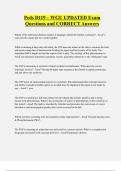
-
Peds D119 – WGU UPDATED Exam Questions and CORRECT Answers
- Exam (elaborations) • 51 pages • 2024
-
- $9.99
- + learn more
Peds D119 – WGU UPDATED Exam Questions and CORRECT Answers Which of the following children requires a language referral for further evaluation? - Ans 2 year old who cannot put two words together While evaluating a three-day-old infant, the FNP turns the infant on the side to examine the back and notes a sharp line of demarcation dividing the upper and lower parts of the body. The dependent half is bright red and the superior half is pale. The etiology of this phenomenon is: - Ans An ...
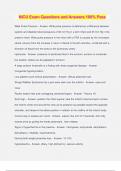
-
NICU Exam Questions and Answers 100% Pass
- Exam (elaborations) • 24 pages • 2024
-
- $13.49
- + learn more
NICU Exam Questions and Answers 100% Pass Wide Pulse Pressure - Answer- Wide pulse pressure is defined as a difference between systolic and diastolic blood pressures of 30 mm Hg in a term infant and 25 mm Hg in the preterm infant. Wide pulse pressure in the infant with a PDA is caused by the increased stroke volume (from the increase in return of blood to the left ventricle), combined with a diversion of blood from the aorta to the pulmonary artery. Hydrocele - Answer- presence of peritone...
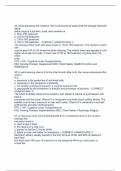
-
COMPLETE EXAMS FOR CHAP 22 MATERNAL CHILD NURSING CARE
- Exam (elaborations) • 19 pages • 2024
-
- $10.99
- + learn more
COMPLETE EXAMS FOR CHAP 22 MATERNAL CHILD NURSING CARE Chapter 22: Physiologic and Behavioral Adaptations of the Newborn Perry: Maternal Child Nursing Care, 6th Edition MULTIPLE CHOICE 1. A woman gave birth to a healthy 7-lb, 13-ounce infant girl. The nurse suggests that the woman place the infant to her breast within 15 minutes after birth. The nurse knows that breastfeeding is effective during the first 30 minutes after birth because this is the: a. transition ...
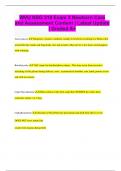
-
WVU NSG 310 Exam 3 Newborn Care and Assessment Content | Latest Update | Graded A+
- Exam (elaborations) • 19 pages • 2024
-
Available in package deal
-
- $10.35
- + learn more
WVU NSG 310 Exam 3 Newborn Care and Assessment Content | Latest Update | Graded A+ Acrocyanosis Temporary cyanotic condition, usually in newborns resulting in a bluish color around the lips, hands and fingernails, feet and toenails. May last for a few hours and disappear with warming. Brachial palsy "Old" name for brachial plexus injury - This may occur from excessive stretching of this plexus during delivery, note : asymmetrical shoulder, arm, hand, posture at rest and with move...
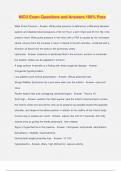
-
NICU Exam Questions and Answers 100% Pass
- Exam (elaborations) • 24 pages • 2024
-
- $12.49
- + learn more
NICU Exam Questions and Answers 100% Pass Wide Pulse Pressure - Answer- Wide pulse pressure is defined as a difference between systolic and diastolic blood pressures of 30 mm Hg in a term infant and 25 mm Hg in the preterm infant. Wide pulse pressure in the infant with a PDA is caused by the increased stroke volume (from the increase in return of blood to the left ventricle), combined with a diversion of blood from the aorta to the pulmonary artery. Hydrocele - Answer- presence of peritone...
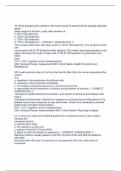
-
COMPLETE EXAMS FOR CHAP 22 MATERNAL CHILD NURSING CARE
- Exam (elaborations) • 19 pages • 2024
-
- $10.49
- + learn more
COMPLETE EXAMS FOR CHAP 22 MATERNAL CHILD NURSING CARE Chapter 22: Physiologic and Behavioral Adaptations of the Newborn Perry: Maternal Child Nursing Care, 6th Edition MULTIPLE CHOICE 1. A woman gave birth to a healthy 7-lb, 13-ounce infant girl. The nurse suggests that the woman place the infant to her breast within 15 minutes after birth. The nurse knows that breastfeeding is effective during the first 30 minutes after birth because this is the: a. transition ...
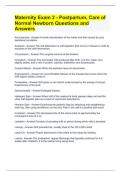
-
Maternity Exam 2 - Postpartum, Care of Normal Newborn Questions and Answers
- Exam (elaborations) • 14 pages • 2024
-
Available in package deal
-
- $14.49
- + learn more
Acrocyanosis - Answer-A bluish discoloration of the hands and feet caused by poor peripheral circulation. Autolysis - Answer-The self-dissolution or self-digestion that occurs in tissues or cells by enzymes in the cells themselves. Circumcision - Answer-The surgical removal of the foreskin. Colostrum - Answer-The first breast milk produced after birth. It is thin, water, and slightly yellow, and is rich in protein, calories, antibodies, and lymphocytes. Cryptorchidism - Answer-When t...
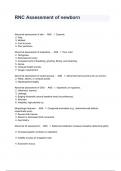
-
RNC Assessment of newborn Questions And Answers
- Exam (elaborations) • 15 pages • 2024
-
- $10.99
- + learn more
RNC Assessment of newborn Questions And Answers Abnormal assessment of skin - ANS 1. Cyanotic. 2. Pale. 3. Mottled. 4. Cool to touch. 5. Poor perfusion. Abnormal assessment of respiratory - ANS 1. Poor color. 2. Tachypnea. 3. Decreased air entry. 4. Increased work of breathing: grunting, flaring, and retracting. 5. Apnea. 6. Unequal breath sounds. 7. Oxygen requirement. Abnormal assessment of cardiovascular - ANS 1. Abnormal heart sounds such ...
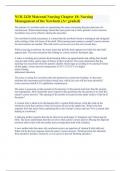
-
NUR 2420 Maternal Nursing Chapter 18: Nursing Management of the Newborn (A+ graded)
- Exam (elaborations) • 9 pages • 2023
-
- $10.99
- + learn more
The parents of a newborn male are questioning the nurse concerning the pros and cons of a circumcision. Which disadvantage should the nurse point out to these parents? correct answers Anesthetic may not be effective during the procedure On a newborn's initial assessment, it is noted that the newborn's head is misshapen and elongated with swelling of the soft tissue of the skull. What nursing intervention is needed? correct answers No interventions are needed. This will resolve on its own ov...

That summary you just bought made someone very happy. Also get paid weekly? Sell your study resources on Stuvia! Discover all about earning on Stuvia


